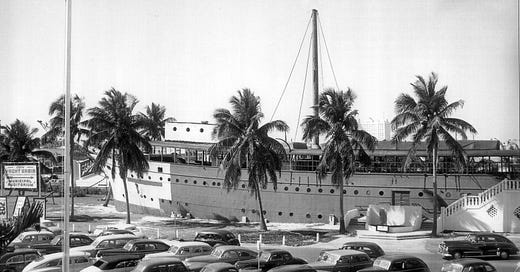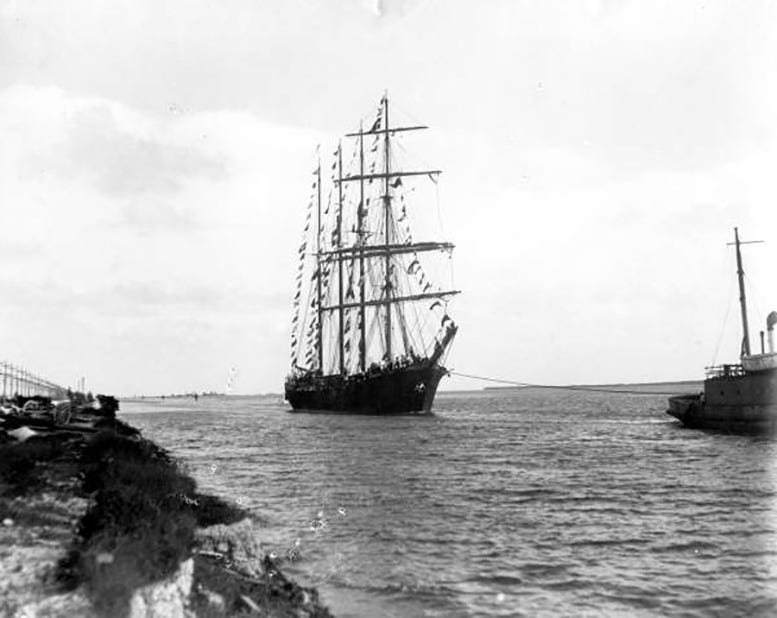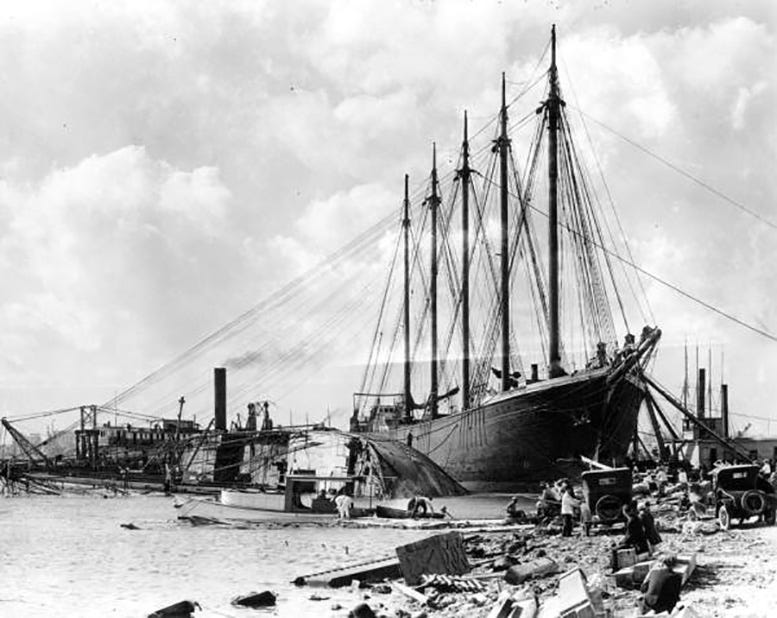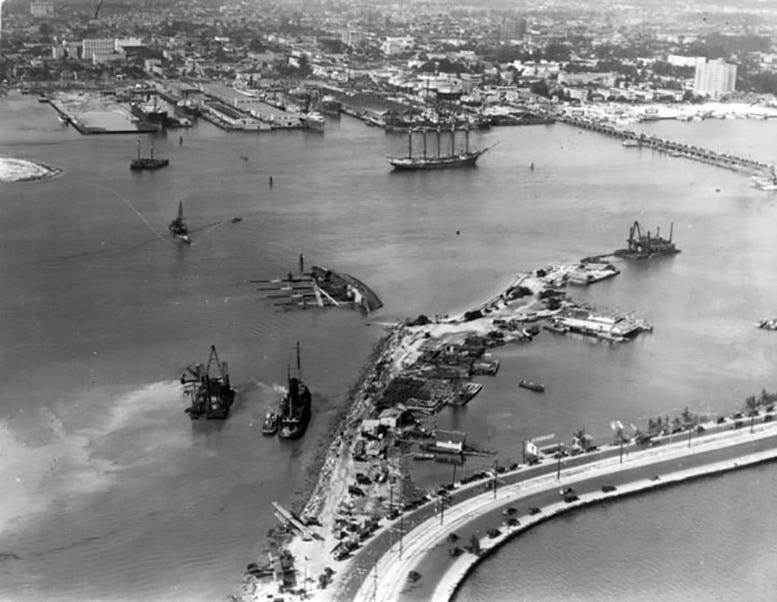Prins Valdemar – A Miami Landmark
The beginning of the end of the 1920s building boom started with the capsize of a schooner at the turning basin for the Port of Miami on January 10, 1926. This is the story of the Prins Valdemar.
The Prins Valdemar was a four-masted Danish barkentine sailing ship that had an interesting journey. Built in 1892, the vessel had served many roles throughout its lifetime: a training ship for naval cadets, blockade runner, gun smuggler, cargo transporter, hotel, aquarium, restaurant, beer parlor, navy chief petty officer’s club, youth center and civil meeting place. It led quite a sixty year existence.
When it was dismantled and sold for scrap in 1952, the Prins Valdemar may have been best known as an aquarium located near Bayfront Park. However, it was shortly after its arrival to Miami when the ship was in the headlines of the local papers for all of the wrong reasons.
The Schooner’s Early History
The Prins Valdemar was built in Helsingør, Denmark, in 1892. The ship was named for a royal prince who won the admiration of his countrymen for refusing the throne of Bulgaria in 1885. She was originally rigged as a barque and served as a training vessel while roaming the high seas.
However, several years after she was commissioned, the ship was caught running guns during the Mexican revolution and was seized by the Mexican government. The ship was sold to an American firm who in turn used it to transport lumber between Australia and the west coast. The ship had a 21 foot deep hold and could pack 1,500,000 feet of lumber between her decks.
The Germans purchased Prins Valdemar and retrofitted the 240 foot vessel as a barkentine. It was used by the Germans as a blockade runner in World War I. The ship was one of the Germans most successful blockade runners until a British torpedo chased it into Copenhagen, a neutral port, where she remained until the end of the war.
After the war, an American syndicate purchased the Prins Valdemar and sailed her into a New York harbor. It sat for two years before being used to transport coconuts from Nicaragua to New York. Given the configuration of the cargo area of the ship, there was a lot of wasted space when shipping coconuts and therefore the Prins Valdemar was not well suited to economically transport coconuts.
Therefore, it was once again used to transport lumber. The transport of building stock is what brought her to Miami.
Retrofit as a Floating Cabaret
Richard J. Walters earned his ship captain’s license in 1923. During World War I, Walters was a commander of the U.S. Army’s Hot Air Balloon division. After earning his captain’s license, Richard partnered with George Risen, who was a New York City hotel owner.
The partnership acquired the Prins Valdemar in 1922 and used it to transport much needed lumber to Miami during the building boom of the mid-1920s. Both men saw another opportunity in Miami. The young city was rapidly growing, and living accommodations were very scarce.
Walters presented Risen with a plan to convert the ship into a floating cabaret with one hundred hotel rooms, a fine restaurant and an entertainment lounge. The plan was for the hotel to be moored alongside a dock in downtown Miami once the conversion was complete.
The Prins Valdemar came into Miami on its final voyage at the end of October in 1925. It was done transporting lumber, and work began to retrofit the ship into a floating cabaret. The grand opening of the hotel was scheduled for January 24, 1926. However, fate had other plans.
Capsized at the Turning Basin
In the early part of January, 1926, the crew was making good progress converting the ship into the cabaret that Walter had envisioned. On Saturday, January 9, the Prins Valdemar was resting on the north bank of the ship channel at the point where it opens to the municipal turning basin. On this day, a combination of receding tides and the location of the ship on the bank placed her in a vulnerable position.
On Sunday, January 10, a strong north wind was blowing, and the force began to tilt the Prins Valdemar to her starboard side. The winds were strong, and it was clear that the ship would capsize. The crew and workman had only four minutes to evacuate the ship. All eighty men escaped as the boat completely turned onto its starboard side. Fortunately, most of the eighty men were on deck and could escape easily. Everyone on board escaped without any casualties.
The position of the ship caused its mast to block the turning basin to the extent that other ships could not leave the port. Salvage crews began immediately to remove the ship out of its capsized position, but it proved very difficult.
It took six weeks to finally prop the ship upright and get it into a position to be moved. It was relocated out of the turning basin into a temporary location until June of 1926. At that time, the Prins Valdemar was moved out of the way and relocated to a dock near SE First Street. The ship remained there for two years until the very persistent Captain Walters figured out a plan to make use of his investment.
Many years later, the Prins Valdemar blocking the turning basin was considered one of several unfortunate events that contributed to the bust of the 1920s building boom. During the six week period to clear the ship from the basin, no shipments of building materials could get into the Miami harbor.
Building activity was impacted by the blockage and many historians believe that this event demonstrated the vulnerabilities of the city. Construction was slowed and the momentum of the 1920s building boom began to wane.
Keep reading with a 7-day free trial
Subscribe to Miami History to keep reading this post and get 7 days of free access to the full post archives.







